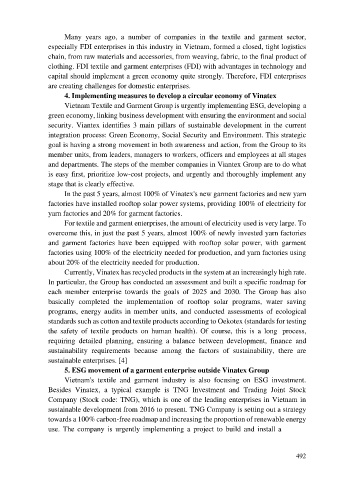Page 500 - Ebook HTKH 2024
P. 500
Many years ago, a number of companies in the textile and garment sector,
especially FDI enterprises in this industry in Vietnam, formed a closed, tight logistics
chain, from raw materials and accessories, from weaving, fabric, to the final product of
clothing. FDI textile and garment enterprises (FDI) with advantages in technology and
capital should implement a green economy quite strongly. Therefore, FDI enterprises
are creating challenges for domestic enterprises.
4. Implementing measures to develop a circular economy of Vinatex
Vietnam Textile and Garment Group is urgently implementing ESG, developing a
green economy, linking business development with ensuring the environment and social
security. Viantex identifies 3 main pillars of sustainable development in the current
integration process: Green Economy, Social Security and Environment. This strategic
goal is having a strong movement in both awareness and action, from the Group to its
member units, from leaders, managers to workers, officers and employees at all stages
and departments. The steps of the member companies in Viantex Group are to do what
is easy first, prioritize low-cost projects, and urgently and thoroughly implement any
stage that is clearly effective.
In the past 5 years, almost 100% of Vinatex's new garment factories and new yarn
factories have installed rooftop solar power systems, providing 100% of electricity for
yarn factories and 20% for garment factories.
For textile and garment enterprises, the amount of electricity used is very large. To
overcome this, in just the past 5 years, almost 100% of newly invested yarn factories
and garment factories have been equipped with rooftop solar power, with garment
factories using 100% of the electricity needed for production, and yarn factories using
about 20% of the electricity needed for production.
Currently, Vinatex has recycled products in the system at an increasingly high rate.
In particular, the Group has conducted an assessment and built a specific roadmap for
each member enterprise towards the goals of 2025 and 2030. The Group has also
basically completed the implementation of rooftop solar programs, water saving
programs, energy audits in member units, and conducted assessments of ecological
standards such as cotton and textile products according to Oekotex (standards for testing
the safety of textile products on human health). Of course, this is a long process,
requiring detailed planning, ensuring a balance between development, finance and
sustainability requirements because among the factors of sustainability, there are
sustainable enterprises. [4]
5. ESG movement of a garment enterprise outside Vinatex Group
Vietnam's textile and garment industry is also focusing on ESG investment.
Besides Vinatex, a typical example is TNG Investment and Trading Joint Stock
Company (Stock code: TNG), which is one of the leading enterprises in Vietnam in
sustainable development from 2016 to present. TNG Company is setting out a strategy
towards a 100% carbon-free roadmap and increasing the proportion of renewable energy
use. The company is urgently implementing a project to build and install a
492

